The HTC One M9 Review: Part 2
by Joshua Ho on April 6, 2015 10:00 AM EST- Posted in
- Smartphones
- HTC
- Qualcomm
- Mobile
- Snapdragon 810
- One M9
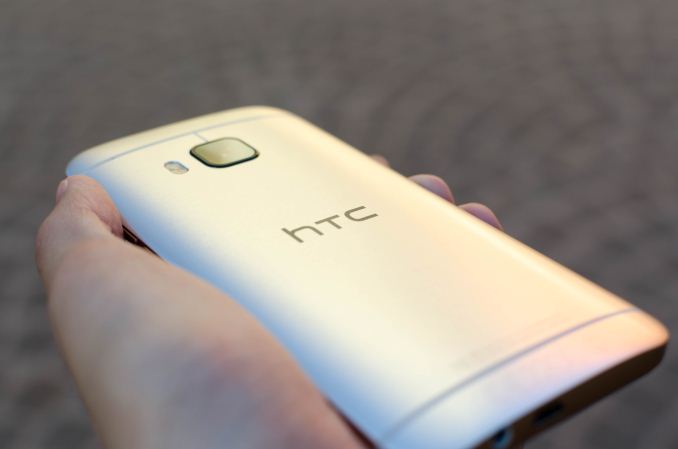
Read First: The HTC One M9 Review Part 1
A good amount of time ago, we posted part one of our HTC One M9 review, which gave a good idea of some critical aspects of the One M9’s performance and design. Unfortunately, due to HTC’s last minute software changes there was a need to redo some of our testing as the changes were quite significant for some key aspects of the user experience, which were effectively any situation where the SoC was in a thermally throttled situation and overall camera performance. I’ve finally finished redoing our testing of the One M9, so we can finish the review and get the full picture of the One M9’s performance. Normally, we’d start by discussing the design of the phone, but much of the review has already been finished with part one. Instead, we’ll start with sustained battery life tests.
Battery Life Continued
As previously detailed, our sustained battery life tests either strongly stress the CPU or GPU. For our GPU tests, we use GFXBench 3.0’s sustained GPU test, which runs the T-Rex benchmark on the display at its native resolution for an infinite rundown test. We didn’t have the modified test to present for a comparison between the two software builds, but we can get a pretty good sense for the changes that have occurred for final shipping software.
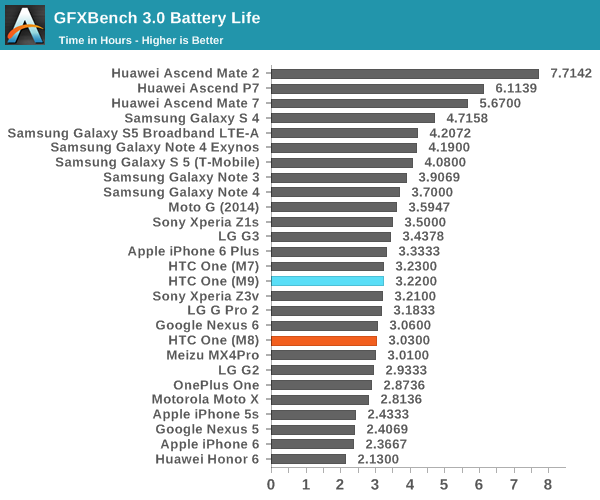
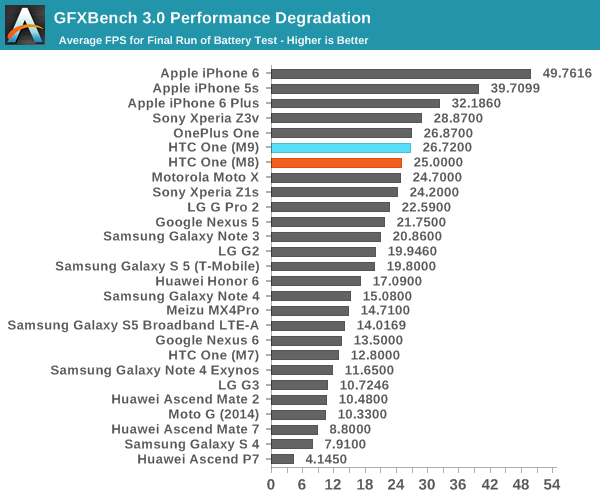
As one can see, the One M9 delivered somewhat impressive sustained performance with the pre-release build, but this resulted in almost dangerous skin temperatures and poor battery life on the order of 1.73 hours. The new update produced acceptable skin temperatures, but frame rate drops rather dramatically as skin temperature rises. The end performance actually ends up being quite similar to the One M8, but performance during the test is much higher than what we saw on the One M8.
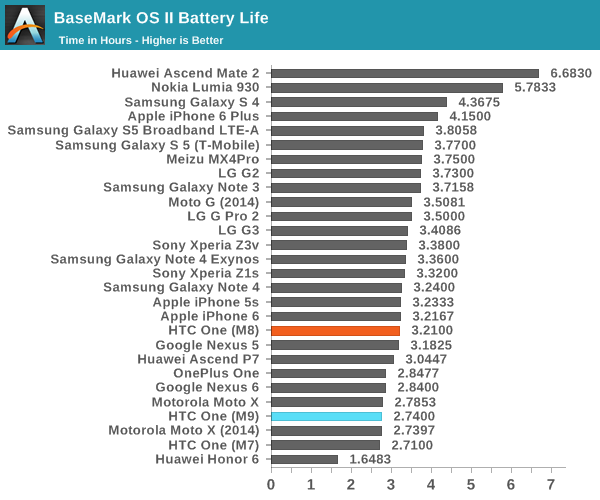

In the Basemark OS II test, we can see that the One M9 seems to perform poorly. One might be able to argue that the A57s provide more performance, but simple logging shows that past the first 20 minutes the A57 cluster is either shut down or throttled to the minimum clock state, although the A53 cluster manages to stay at 1.56 GHz for the duration of the test. For reference, the One M8 manages to keep the active CPUs at around 1.5 GHz throughout the test.
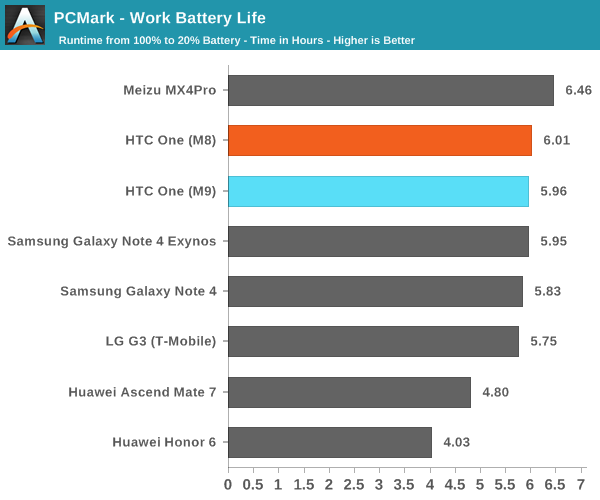
While Basemark OS II and GFXBench function as power virus tests, I wanted to get a good idea of performance somewhere between these rather extreme tests and the mostly display-bound web browsing test. To do this, I tested a few devices against PCMark’s work battery life benchmark, which shows that the One M9 seems to perform comparably when compared against the One M8. There is a noticeable difference in performance, but the gap isn’t all that big when compared to the M8. More interestingly is that the battery temperature sensor (which isn't necessarily on the battery) gets noticeably higher than the M8, on the order of 5-10C higher.
It’s a bit frightening to see that the gap in performance that we saw with the web browsing test remain. The effects of panel-self refresh would be greatly reduced in these short-running tests, so the differences here are mostly due to the SoC. The level of throttling I’ve seen here is pretty much unprecedented, which doesn’t help with the issue. Overall, the performance of Snapdragon 810 here is bad enough that I would genuinely consider Snapdragon 805 to be an improvement. I can’t help but wonder if this was inevitable though, as leaked roadmaps in the past suggested that Snapdragon 810 would’ve been a very different SoC.


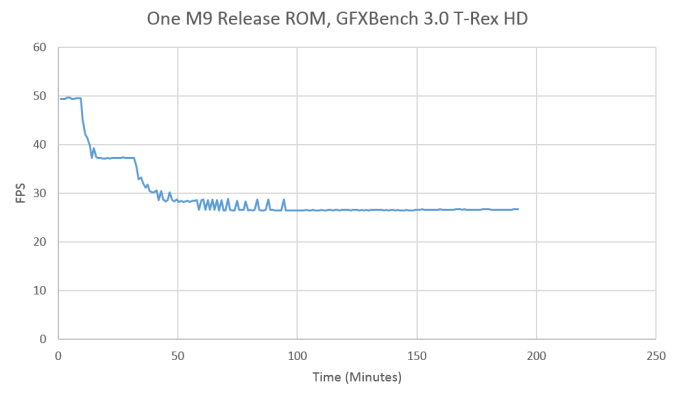
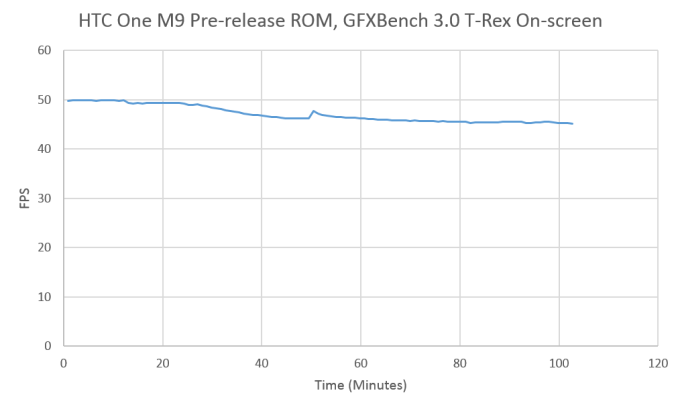








127 Comments
View All Comments
sinPiEqualsZero - Monday, April 6, 2015 - link
I would have been happy with it being similar to the M8 if it didn't regress in so many categories. There must have been a new manager or director somewhere along the line as the M8 was right up there with all of the flagships.And as Refuge pointed out the M8 was released for Windows. I wasn't ready to upgrade my Lumia 928 then but it sure is showing its age now. With no viable WP flagship coming up I think it's time to switch. Bah.
kspirit - Tuesday, April 7, 2015 - link
Wait for the upcoming Lumia flagship. It'll be the same wait until when HTC launches the M9 for Windows as well. I'm holding on to my 925 until the WP10 Lumia announcement myself :) Although an "Ativ" S6 would be quite the marvellous device.sinPiEqualsZero - Wednesday, April 8, 2015 - link
I'm not holding my breath for it. It's been rumored for well over a year and there's still no release date. I'm making my decision around mid to late May and if it isn't out by then I'm doing Android.Flunk - Monday, April 6, 2015 - link
At one point HTC was the company to beat when it came to Android Smartphones. It seems like all they do now is make inferior clones of the HTC One (M7 in HTC-speak). It seems like they're actively trying to fail, especially since they're a practical non-entity marketing wise and Apple and Samsung dump millions into marketing.pedromcm.pm - Monday, April 6, 2015 - link
Apple and Samsung will bury the M9 because their products are better, not because of marketing.hung2900 - Monday, April 6, 2015 - link
And shooting in 0.5 shutter? R u serious? These photos were shot by tripod.DanNeely - Monday, April 6, 2015 - link
Half a second is the total time to take and save an image; not the shutter time. Most of it is pre-processing between when the button is pressed and the sensor exposed, post-processing after eposure to turn the raw image from the sensor into something to show on the screen and save as a jpeg, and the time spend to write to flash itself.GC2:CS - Monday, April 6, 2015 - link
So the snapdragon 810 overheating and efficiency problems are more or less included in this phone ?That's very bad.
I heard about adreno 420 throttling problems which limited it to "not so much faster than 801" and this 810 is just a bit faster than 805.... We had seen a big perf jump from M7 to M8 but where are those 80% improved performance that qualcom promised last year compared to adreno 330 ?
And 20nm should have brought some rather significant efficiency gains... So what happened ? Apple is leaving only low quality wafers to their competition at TSMC or what ?
Because A8 is maybe slower at imediate benchmarks but the combination of a suposedly far more efficient architecture than the competition ( little heat = little throtling) and relativelly low resolution displays makes iPhones fly.
I even seen that galaxy S6 has problems sustaining their performance and even bigger than HTC thanks to it's QHD display.
Maybe the LG G4 can surprise us as snapdragon 808 could possibly sustan performance better....
Refuge - Monday, April 6, 2015 - link
LG sure does know how to make a phone.My girlfriend has had both the G2 and G3 now.
These things are amazing, fantastic speakers, absolutely gorgeous screen, fast and clear camera, fastest phone I've been able to play with in awhile, and also the battery life? My old lady is glued to her phone for work constantly, and she can get 2 days out of it. If I were to use it I could get 3.
I would switch myself from my M7 to one, but I hate the sleep button on the back, and I hate how big it is! Those are really big screens, too much for me to be interested in it being in my pocket on the regular.
kspirit - Tuesday, April 7, 2015 - link
+1 for the G2 and G3. Hopefully the G4 will slay just as hard.